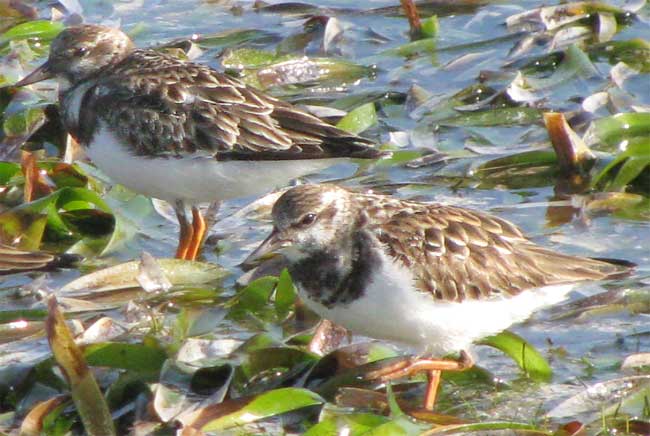Excerpts from Jim Conrad's
Naturalist Newsletter
from the November 15, 2005 Newsletter written at Hacienda San Juan Lizarraga
one kilometer east of Telchac Pueblo, Yucatán, MÉXICO A sulfurous odor hung in the air as I hiked along the beach this week. Probably the wind carried the stench from many miles to the north where oil drilling platforms abound. A dead sea turtle lay on the beach, a young one only about 18 inches long. With my foot I flipped him over and there in a cavity in the sand where he'd lain was a hand-sized, almost white crab with two stalked eyes so black and shiny they looked like wet obsidian BBs. What a cozy setup that crab had, able to stay in his hidden little cellar eating dead-turtle roof whenever he wanted. I replaced the roof and was glad that at least a handsome crab was benefiting from the young turtle's tragedy. Poking in a pile of dark brown, washed-up seaweed not far away were four small shorebirds of the fast- running, toothpick-legged kind. One bird was larger than the others and besides his drab winter plumage had reddish legs and a dark chest band. The fieldmark that really gave away his identify, however, was his slightly upturned, sharp-pointed little beak. He was a Ruddy Turnstone. Turnstones get their name from their habit of walking along shore flipping small stones with their specially designed beaks, foraging on critters beneath them. Of course that's a Ruddy Turnstone above. His smaller companions, as plain as they could be in the usual winter-shorebird plumage of grayish upperparts and whitish underparts, were Sanderlings, the classic shorebird. "Classic" because, in my experience, no other bird spends more time chasing waves out to sea, pecking in the sand as they go, then being chased back inland by incoming waves -- this again and again as they generally work up or down the beach. You can see one at https://ebird.org/species/sander. Both turnstone and Sanderlings breed in the far, far north, deep within the Arctic along the northernmost coasts of Alaska, Canada and Greenland. Both species also overwinter along shores all the way south from both US coasts to southern South America. Watching these birds I tried to visualize where they'd just come from -- cold, windswept, mostly barren, dark gray, wave-lapped, rocky shores with leaden sky and frequent icy showers, an infinity of mosquitoes, and that weak, opaque sun ever so low, circling around and around behind the gray haze but never dipping below the horizon. But now here they are on this hot, sandy beach with dazzling sunlight and silky nights. These birds have evolved for two very different lives and one has to marvel that such fragile-looking creatures can endure such changes and such long trips twice a year.
RUDDY TURNSTONE


from the January 5, 2009 Newsletter written at Mayan Beach Garden Inn 20 km north of Mahahual
on the Yucatán Peninsula's eastern coast just north of the Belize border,
in the state of Quintana Roo, MÉXICO
LOLLING RUDDY TURNSTONE
I like the above picture because it hints at what it must feel like being a Ruddy Turnstone out there on a shoal at low tide, plenty of food down in the Turtlegrass, late-afternoon sunlight warming your back as a hard wind blows in off the Gulf, and you have nothing to do but digest and hang out with friends. The birds are atop a car-sized Turtlegrass shoal just up the beach from the hotel.